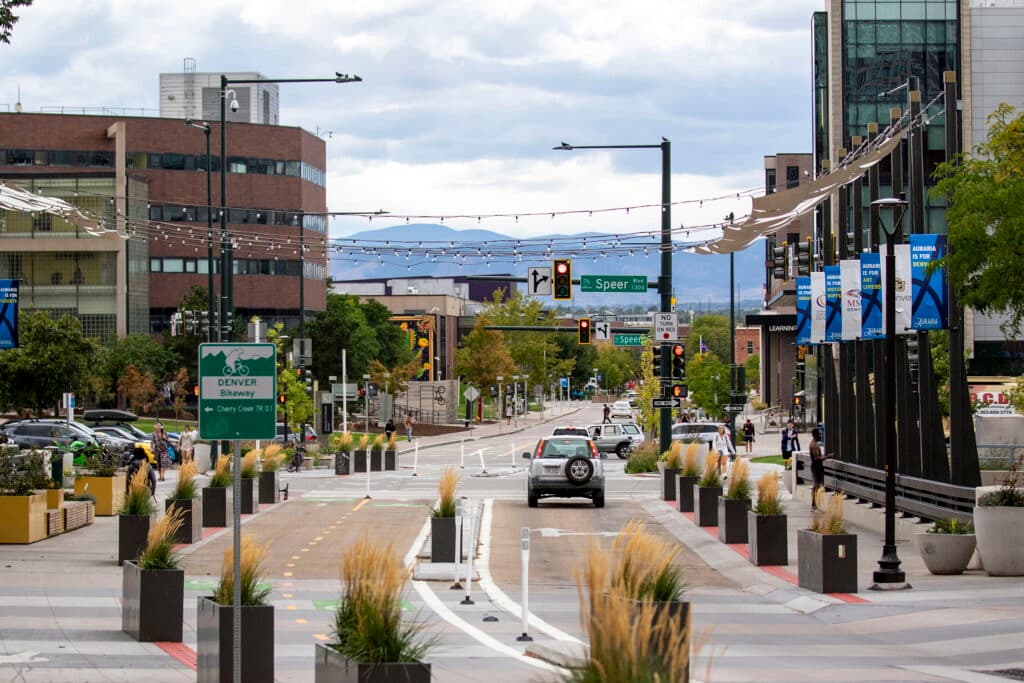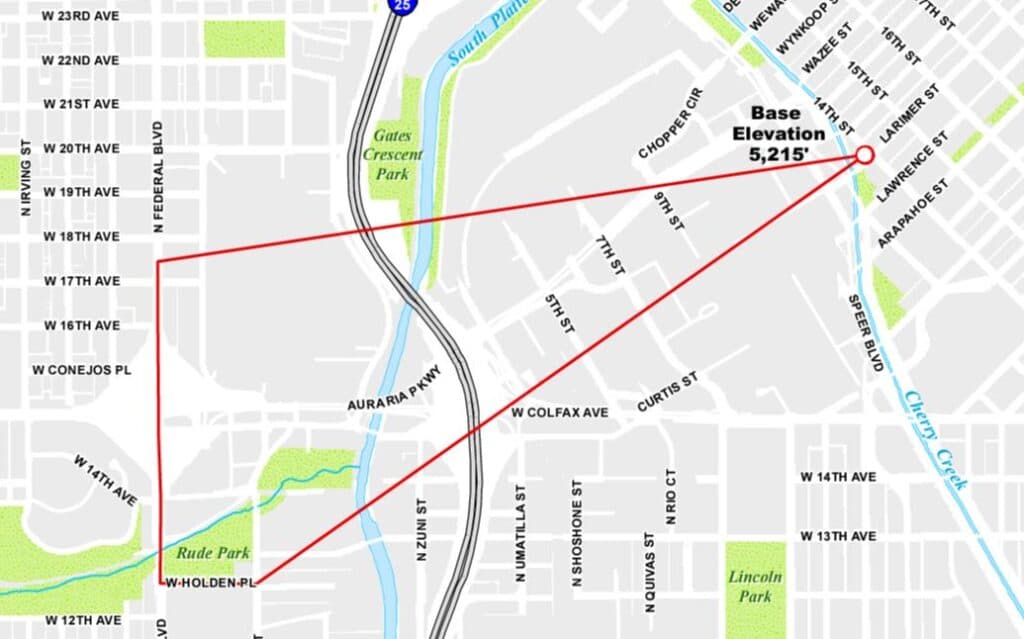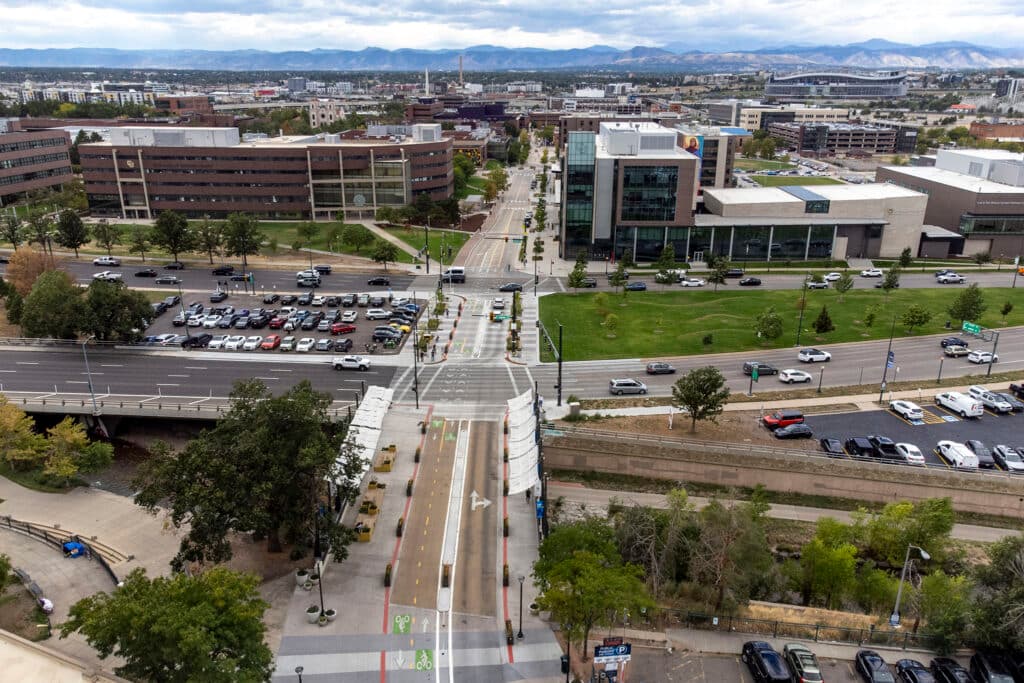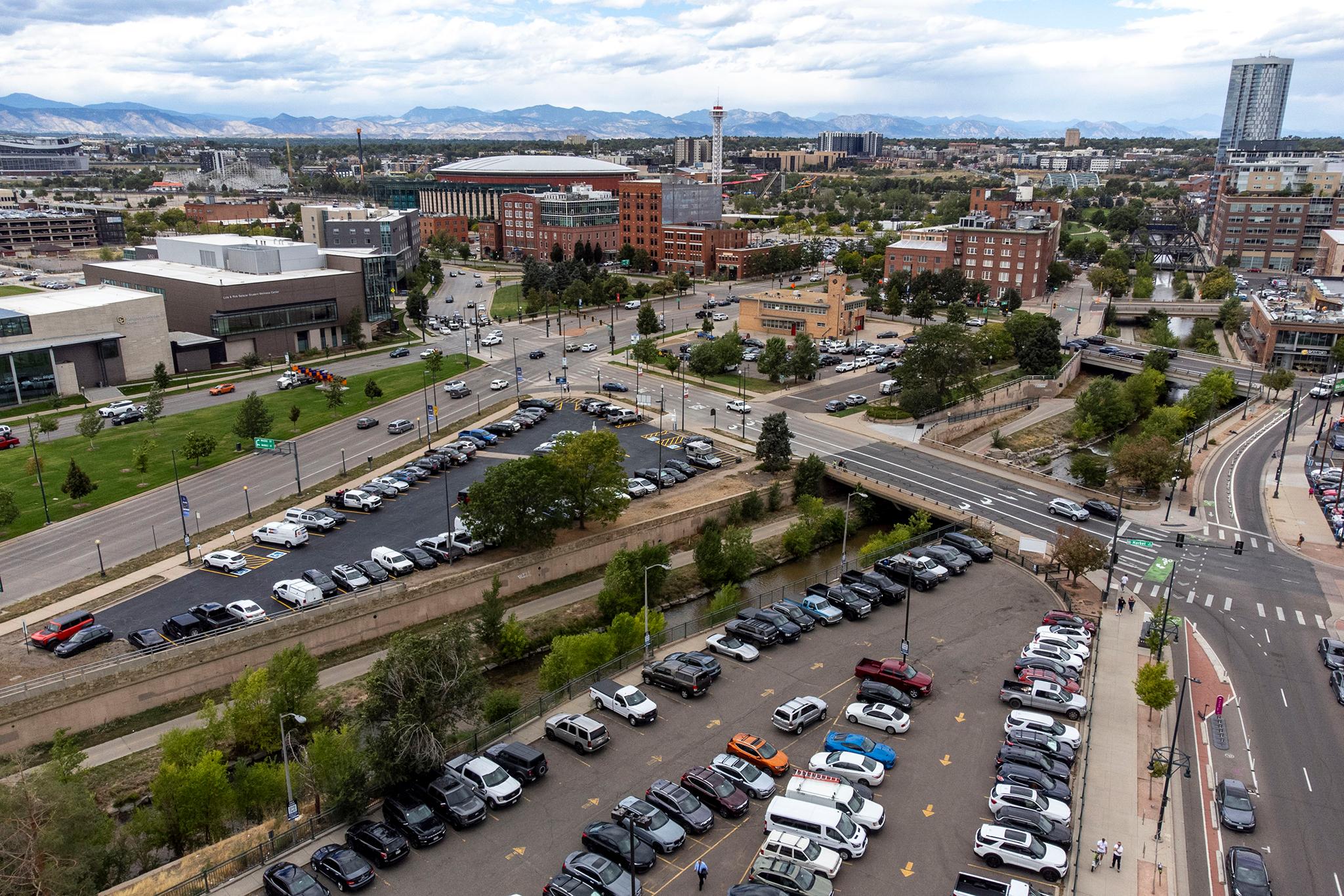Kroenke Sports and Entertainment’s massive mixed-use development of 65 acres of Ball Arena parking lots has some downtown neighbors wondering: Why are you gonna kill my killer mountain views?
It’s not a gripe most Denverites will have about the project, since most Denverites don’t have mountain views. But those who do pay a pretty price for it, and they currently have legal protections for their pricy panoramas.
The project, as planned, would put 6,000 units of new housing around the arena. Of those, 1,080 would be income-restricted. Kroenke is also looking at building new hotels, offices and an entertainment venue to create a 24/7 neighborhood.
In certain parts of the property, city officials could allow new towers to rise dozens of floors, potentially blocking mountain views from downtown. Building that high would require changing a city law that has limited building heights in order to protect the area’s “view plane.” City council will soon consider doing that.

Some neighbors are pushing back on plans to remove their protected views.
For Kroenke to build tall on the parking lots, council would have to scrap language in the city’s municipal code that protects the "Old City Hall" view plane from tall development west of downtown.
Urban planners and developers worry those legal restrictions are making it harder to build dense housing, and they say housing is something the city desperately needs. (The developers would also have to include affordable housing if they want to be allowed to build especially high.)
City planners have been suggesting lawmakers do away with that view plane for years to allow for more development to the west of downtown. But neighbors with mountain views say that isn’t fair. Views of the mountains are a key part of the city’s character, some residents argue.
Take Casey Pitinga. She purchased a condo at 15th and Larimer streets back in 2018. She researched the view plane when she was buying her home.
“The height restrictions which enabled views of the mountains are why many property owners in Denver purchased their properties there,” Pitinga told Denver City Council members serving on the South Platte River Committee. “Amending the ordinance would affect not only the views but also the property values of many residents and businesses in downtown Denver. This could create a hardship for all of those who, over the decades, have invested in their properties, expecting the city ordinances to be upheld.”
The development is one part of Kroenke's and others’ efforts to more than double downtown Denver in size. Big projects that will transform the landscape — and the views — include the River Mile, new development at the Auraria Higher Education Campus, as well as plans for Sun Valley and possibly Burnham Yard.
City planners say the Ball Arena development is bringing the promise of affordable housing, new green space, greater connectivity between various parts of town, and that the tradeoff with the Old City Hall view plane is worth it.

What is the Old City Hall view plane, anyhow?
Denver's Old City Hall was torn down back in 1936. The only thing left there is the building’s bell and a small park. There’s also a view of the mountains from the site — one that was legally protected in 1988, when city council created the view plane.
It’s one of several view planes that prevent development from getting in the way of the sights.
“Each view plane is established to protect a certain panoramic view from parks or public spaces,” explained Tony Lechuga, a senior city planner with the Department of Community Planning and Development.
City documents show fourteen view planes, including ones to protect the views from Cheesman, Ruby Hill, Sloan’s Lake and City parks, as well as from the State Capitol, the Botanic Gardens, Coors Field and Civic Center. Some protect views of the parks, while others are meant to keep the mountains in sight.
The Old City Hall view plane starts at Larimer and 14th streets and forms a “V” shape that stretches all the way to Federal Boulevard. By law, tall buildings aren’t allowed in that area.

The only time city lawmakers passed an exception to this view plane was in 1999, for the new Broncos’stadium. The Auraria Higher Education Campus is also exempt from the Old City Hall view plane regulations because it’s a state property.
In 2018, city council instructed city planners to consider getting rid of the Old City Hall view plane, which was part of a broader downtown planning effort.
In 2019, the city adopted design standards and guidelines that stated that when new buildings are built, views of natural areas should be protected — view plane or not. But those protections are more like suggestions, not strict limits on building sizes.
City planners say those 2019 standards should be enough to let sunlight in, ensure spacing between buildings and preserve some limited views of the mountains, with or without a protected view plane.
“Ultimately, that means any tall tower built in this area will have to go through that additional review to see how we are impacting views,” Lechuga said.

Why does the city want to kill the view plane?
For one, the view is already wounded, in part, by the Auraria Higher Education Campus.
“They are a state-run enterprise, and they are not obligated to follow the zoning rules that we've established, and they've taken advantage of that,” explained Lechuga.
Residents who oppose striking the view plane say they’re pleased the campus didn’t build too tall despite being exempted from the view rules. But some fear Kroenke, as a private developer, won’t do the same. (Building heights are still limited by other laws and physical limitations.)
With the view plane restrictions out of the way, city rules would allow the developer to build higher if affordable housing is included in the project. The move would incentivize the creation of more affordable units. And with the gap between wages and home prices expanding, that’s something the city argues Denver needs.
“By removing the view plane, we're actually incentivizing and allowing any development to tap into our built in incentives to provide affordable housing in excess of 70 feet,” Lechuga said.
Neighbors have different views on losing views
Protecting views is far from a unanimous desire for neighbors of the Ball Arena project.
Many council members’ support for the project hinges on Kroenke signing a community benefits agreement with a different group of neighbors from multiple communities surrounding the city center. They call themselves the Ball Arena Community Benefits Agreement Committee, or BACBAC.
The BACBAC is more concerned about open space accessibility and how much affordable housing the project will bring. They want it to honor Indigenous histories and the families of former Aurarians displaced by the big campus decades ago.
“The BACBAC supports removing the view plane on the Ball Arena property, provided that we reach a signed Community Benefits Agreement with the developer,” wrote the committee in a statement. “This agreement must align with the overarching goals of the Ball Arena CBA Committee, including a commitment to ensuring 18% of the housing built on-site is affordable.”
Council has also heard different perspectives from those whose views would be affected.
Suzanne Hefty lives in a 31-story red brick high rise at 15th and Larimer streets with roughly 300 residents, with views over Auraria and up toward Boulder. She says she’s pro-development, and she’s OK with changes to the view plane — but she’s worried about what will come next.
“It's just really important to make Denver maintain its western vibe and to be able to see the mountains from various points downtown,” Hefty told members of the South Platte River Committee.
She points to the Confluence apartment building, which spears upward from the otherwise low-profile area near Confluence Park, as an example of her concerns.

“It does not have any relationship to anything else in its neighborhood, and that's what I'm really afraid of on the Kroenke property,” she said.
Downtown resident Pitinga has a different idea. She wants voters to decide, with the Kroenke development plan going on the ballot during an election year.
“I believe that if you amend the view plan ordinance, you're not only affecting the beauty of Denver, which attracts people that visit and live here, but [you’re] also saying that Denver is for sale to wealthy developers,” she said.
So, what’s next?
The city council’s South Platte River Committee sent the view plane amendment and other related items to the full city council for a vote later this fall.
But the committee still has to vote on a lingering item regarding the Kroenke development: the creation of municipal districts to help fund the project. The committee is set to vote on that item in early October.
If that passes, the full development project proposal would be considered by city council later this fall, and the public will have the chance to comment further.

